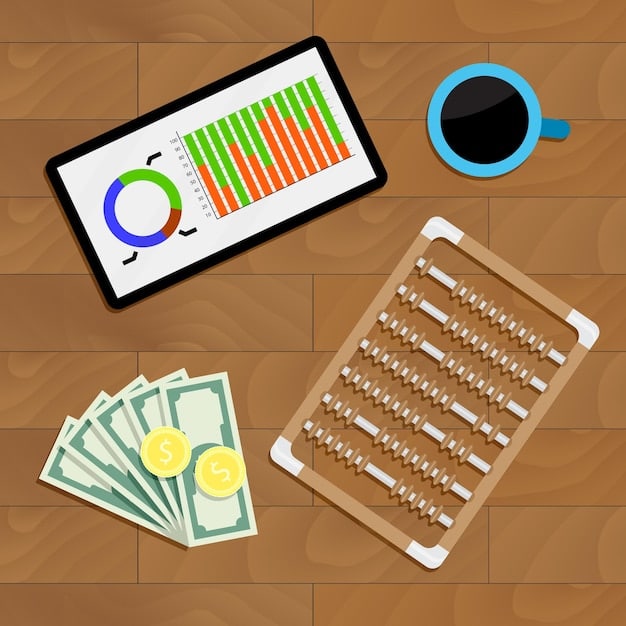Decoding Your Credit Score: A 2025 Guide to Payment History

Understanding your credit score is crucial for financial health, and in 2025, payment history remains a significant factor, accounting for 35% of your score; this guide breaks down how it impacts your creditworthiness and what you can do to improve it.
Your credit score is a key indicator of your financial health, influencing everything from loan approvals to interest rates. In the landscape of 2025, understanding the factors that contribute to this score is more important than ever. One of the most significant of these is payment history. Let’s delve into decoding your credit score: a 2025 guide to understanding the 35% payment history factor.
Understanding the Credit Score Landscape in 2025
In 2025, while technology and financial products have evolved, the fundamental principles of credit scoring remain largely the same. Credit scores are still used by lenders to assess the risk of lending money to individuals. However, the data sources and analytical models used to calculate these scores have become more sophisticated.
The Importance of Credit Scores
A good credit score can unlock better interest rates on loans, credit cards, and mortgages. It can also affect your ability to rent an apartment, get approved for insurance, and even influence job opportunities. Credit scores essentially reflect your financial trustworthiness.
Key Factors Influencing Credit Scores
While several factors influence your credit score, payment history, amounts owed, length of credit history, credit mix, and new credit are the primary components. Among these, payment history carries the most weight, typically accounting for 35% of your score.

To keep your credit score healthy, consider these points:
- Timely Payments: Always pay your bills on time.
- Credit Utilization: Keep your credit card balances low relative to your credit limits.
- Regular Monitoring: Check your credit report regularly for any errors or discrepancies.
Understanding the credit score landscape in 2025 means being proactive about managing your credit and staying informed about the factors that influence your score. By focusing on key areas such as payment history, you can significantly improve your financial standing.
The 35% Rule: Payment History Breakdown
Payment history is a critical component of your credit score, reflecting how consistently you’ve made payments on your credit accounts over time. It tells lenders whether you’re a reliable borrower who pays debts as agreed.
What Constitutes Payment History?
Payment history includes information about your payments on credit cards, loans (including student loans, auto loans, and mortgages), and other lines of credit. It indicates whether you’ve paid on time, how late you’ve been, and how frequently you’ve missed payments.
Impact of Payment History on Credit Score
A positive payment history can significantly boost your credit score, whereas negative marks, such as late payments or defaults, can substantially lower it. The impact of missed payments can linger for years, affecting your ability to access credit and secure favorable terms.
Strategies for Maintaining a Positive Payment History
To ensure a positive payment history, consider the following strategies:
- Set Up Payment Reminders: Use calendars or apps to remind you when bills are due.
- Automate Payments: Enroll in automatic payments to ensure bills are paid on time.
- Pay More Than the Minimum: If possible, pay more than the minimum amount due to reduce your balance faster.
Understanding the 35% rule and focusing on maintaining a positive payment history is vital for building and sustaining a healthy credit score. By adopting smart financial habits, you can improve your creditworthiness and unlock better financial opportunities.
Late Payments: The Domino Effect
Late payments can set off a domino effect that negatively impacts your credit score and overall financial health. Understanding the consequences of late payments can motivate you to prioritize timely payments.
Immediate Impact on Credit Score
A single late payment can lower your credit score, particularly if you have a thin credit file or a previously spotless record. The severity of the impact depends on how late the payment is and your overall credit profile.
Long-Term Financial Consequences
Late payments can lead to higher interest rates on loans and credit cards, increased insurance premiums, and difficulty securing approvals for future credit applications. These financial consequences can add up over time, making it harder to achieve your financial goals.

Mitigating the Damage of Late Payments
If you’ve made a late payment, here’s how to mitigate the damage:
- Contact the Creditor: Explain the situation and ask if they can waive any late fees or avoid reporting the late payment to credit bureaus.
- Catch Up Immediately: Make the payment as soon as possible to minimize the negative impact.
- Review Your Credit Report: Check your credit report for any inaccuracies and dispute them with the credit bureaus.
Understanding the domino effect of late payments underscores the importance of proactive financial management. By avoiding late payments and taking swift action when they occur, you can safeguard your credit score and financial well-being.
Credit Utilization and Its Indirect Impact
Credit utilization, the amount of credit you’re using compared to your total available credit, indirectly affects your payment history. High credit utilization can make it harder to make timely payments, leading to negative marks on your credit report.
Credit utilization is calculated by dividing the total balance on your credit cards by the sum of your credit limits. For example, if you have a credit card with a $1,000 limit and a balance of $300, your credit utilization is 30%.
Optimal Credit Utilization Ratio
Experts recommend keeping your credit utilization below 30%. Lower utilization rates demonstrate responsible credit management and can positively influence your credit score. High utilization, on the other hand, signals reliance on credit and can lower your score.
Strategies for Managing Credit Utilization
To manage credit utilization effectively:
- Pay Down Balances: Reduce your credit card balances to lower your utilization rate.
- Increase Credit Limits: Request higher credit limits from your credit card issuers, but be sure not to overspend.
- Use Multiple Cards Wisely: Spread your spending across multiple credit cards to keep the utilization rate low on each card.
The Link Between Credit Utilization and Payment History
High credit utilization can strain your budget, making it harder to make timely payments on all your credit accounts. This can lead to late payments, which directly affect your payment history and credit score. Managing credit utilization is therefore crucial for maintaining a positive payment history.
Understanding the indirect impact of credit utilization on payment history highlights the interconnectedness of credit management practices. By keeping credit utilization low, you can improve your ability to make timely payments and boost your overall creditworthiness.
Beyond Payment History: Other Factors to Consider
While payment history is a significant factor in determining your credit score, it’s not the only one. Understanding the other components of your credit score can provide a holistic view of your creditworthiness.
Amounts Owed
Amounts owed, or credit utilization, accounts for about 30% of your credit score. Keeping your credit card balances low relative to your credit limits is essential for maintaining a good score.
Length of Credit History
The length of your credit history makes up about 15% of your score. A longer credit history generally indicates a more reliable track record, which can positively influence your score.
To improve your credit history, consider these factors:
- Keep Old Accounts Open: Unless there’s a compelling reason to close them, keep older credit accounts open to maintain a longer credit history.
- Use Credit Regularly: Use your credit accounts periodically to keep them active, but always pay on time.
- Avoid Opening Too Many New Accounts: Opening several new credit accounts in a short period can lower your average account age.
Credit Mix and New Credit
Credit mix and new credit account for 10% each of your credit score. A healthy mix of credit accounts (such as credit cards, loans, and mortgages) can demonstrate responsible credit management. However, avoid opening too many new accounts at once, as this can lower your average account age and potentially lower your score.
Looking beyond payment history and understanding all the factors that influence your credit score can empower you to take a comprehensive approach to credit management. By addressing each component, you can build a strong credit profile and unlock better financial opportunities.
Future-Proofing Your Credit Score in 2025 and Beyond
To future-proof your credit score in 2025 and beyond, it’s essential to stay informed about emerging credit trends and adopt proactive financial management strategies. The financial landscape is continually evolving, and your credit score needs to keep pace.
Emerging Credit Trends
In 2025, expect to see greater use of alternative data in credit scoring, such as utility payments, rent payments, and even social media activity. Lenders are increasingly looking beyond traditional credit reports to assess creditworthiness. Additionally, advancements in artificial intelligence and machine learning are transforming credit risk assessment.
Proactive Financial Management Strategies
To future-proof your credit score:
- Monitor Your Credit Report Regularly: Check your credit report for errors or discrepancies and address them promptly.
- Diversify Your Credit Portfolio: Maintain a healthy mix of credit accounts, but avoid overextending yourself.
- Stay Informed: Keep abreast of changes in credit scoring models and industry best practices.
The Role of Financial Literacy
Financial literacy is key to navigating the complexities of credit management. Understanding credit scores, interest rates, and debt management strategies can empower you to make informed financial decisions and safeguard your credit health. Invest in financial education resources and seek advice from trusted financial professionals.
| Key Point | Brief Description |
|---|---|
| 💸 Payment History | Accounts for 35% of your credit score. |
| 📊 Credit Utilization | Keep it below 30% for a better score. |
| 📅 Payment Reminders | Use reminders or automate payments to avoid late fees. |
| ✅ Regular Monitoring | Check your credit report regularly for any errors. |
Frequently Asked Questions (FAQ)
▼
Payment history is crucial because it demonstrates your reliability in repaying debts. Lenders use it to assess the risk of lending you money, making it a significant factor in determining your creditworthiness.
▼
A late payment can affect your credit score for up to seven years, although its impact diminishes over time. The more recent the late payment, the greater the negative effect on your score.
▼
A good credit utilization ratio is typically below 30%. This means that if you have a credit card with a $1,000 limit, you should aim to keep your balance below $300.
▼
While there’s no instant fix, you can improve your credit score by making timely payments, reducing credit card balances, and addressing any errors on your credit report. Consistency is key.
▼
It’s recommended to check your credit report at least once a year to ensure accuracy and identify any potential issues. You can obtain free credit reports from the three major credit bureaus.
Conclusion
In conclusion, understanding and managing your payment history is essential for maintaining a healthy credit score in 2025. By adopting proactive financial management strategies and staying informed about emerging credit trends, you can future-proof your credit score and unlock better financial opportunities. Prioritize timely payments, manage credit utilization effectively, and continuously monitor your credit report to ensure a strong and reliable credit profile.





